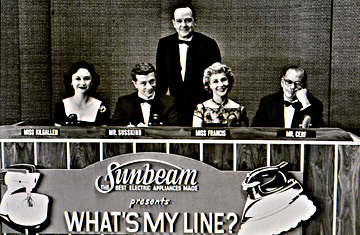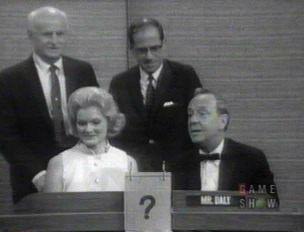
1950-1967 VERSION

1950-1967 VERSION
Broadcast history:
First aired: February 2, 1950
Last aired: September 3, 1967
Network: CBS
Best known time slot: Sunday nights 10:30 EST (10/51-9/67)
Host

John Daly
Guest hosts: Bennett Cerf, Eamonn Andrews, Clifton Fadiman
Regular Panelists


Dorothy Kilgallen (2/50-11/65), Arlene Francis (2/50-9/67), Bennett Cerf (3/51-9/67)
Also: Louis Untermyer (2/50-3/51), Hal Block (3/50-53), Steve Allen (53-54), Fred Allen (54-56), Ernie Kovacs (late 50's) and Martin Gabel.
Announcers: Lee Vines (1950-1955), Hal Simms (1955-1961), Ralph Paul (1961), and Johnny Olson (11/61-9/67)
Substitute announcers: Bern Bennett, John Briggs, Dick Stark and Jack Clark
Origination: Grand Central Studios and CBS Studios 52, 59, and 50 (Ed Sullivan Theater) in New York City.
Theme song: "Rollercoaster", by Milton Delugg and Lou Burch (Played at the end of most shows)
Sponsors - Click here for a list.
What's My Line? was one of the earliest sucesses of Mark Goodson/Bill Todman Productions. It premiered on the CBS primetime schedule on Thursday, February 2, 1950 at 8:00PM EST, broadcasting from the CBS television studio at New York's Grand Central Station, airing on alternate weeks at first.
Next, the show's first time change came in April 1950 when it moved to 9:00PM EST Wednesdays, again on alternate weeks.
Then, the show began to air weekly starting on October 1st, 1950, when CBS moved the show to Sunday nights at 10:30PM EST, where it remained until the final broadcast on September 3, 1967.
Every episode aired were original, while most shows were broadcast live, some were pre-recorded, even during the summers. Reruns never aired until the launch of Game Show Network (now GSN) in December, 1994.
The object of the game was for four panelists to try to guess unusual occupations of contestants or a product associated with them.
The contestant's line appeared on the TV screen for the audience at the studio and home to see. (Home viewers could even play along by looking away from their TV set if they wanted)
Until the telecast of April 17, 1955, each panelist had the right to make a gag "wild guess" at the contestant's occupation. On at least three occasions that a panelist correctly identified the contestant's occupation right off the bat! If the wild guess was wrong, then the game would go on.
A panelist would ask a question and the contestant would either answer "yes" or "no". If "yes", then the panelist would ask another question until a "no" answer is reached, and play would pass on clockwise to the next panelist.
Throughout the entire show's run, a "no" answer would earn a contestant $5.
The game ended when either the occupation is correctly identified, or ten "no" answers were given. The most a contestant would earn was $50.
Near the end of the telecast, or sometimes in the beginning, a special round was played in which the panel would try to identify a celebrity "Mystery Guest" while blindfolded.
The mystery guest had the right to disguise his or her voice so that identification could be avoided quickly.
Play was the same as in the regular game until the telecast on April 17, 1955, when the rule changed in which each panelist would ask one question at a time moving clockwise.
The Mystery Guest round continued until either one of three things happened: the mystery guest is indentified, ten "no" answers were given, or when time ran out.

The panel on the first broadcast were syndicated newspaper columnist Dorothy Kilgallen (who remained with the show until her death in 1965), former New Jersey Gov. Harold Hoffman, psychiatrist Dr. Richard Hoffman (no relation), and poet/critic Louis Untermeyer.
The first contestants were Pat Finch (a hat check girl from the Stork Club), Arthur Feinberg (an executive from the Cascade Diaper Club), and Dr. Seymour Kolodny (a veterinarian).

Only on the first telecast were the blindfolds handed to the panel by Madeline Tyler.

The first mystery guest was New York Yankee shortstop Phil Rizutto.
At first, the panel and host were dressed in the usual semi-formal way, but before long, they were all dressed very formal with the men in tuxedos and the ladies in evening gowns.

The show's set was very basic (and what you'd expect in the early days of television): A desk big enough for the four panelists (with their name plates right in front of them, either starting respectfully with Mr. or Miss), another desk for the host (with his name plate in front, usually "Mr. Daly") and the contestants & mystery guests (with their full name plate in front while the Mystery Guest portion was played), and a chalkboard where the contestants would "Sign in, please." upon entering.
On the first broadcast, the chalkboard was on stage left, the host's desk on the right of the chalkboard, and the panel's desk in the middle. A huge curtain was in the background.
After the first broadcast (And as Franklin Heller stepped in as director for the next 17 years), the set was scapped in favor of the one we all became familiar with.
The chalkboard was in the middle, the host's desk on the right, and the panel's desk on the left. The set would be enhanced with the show's title on the panel's desk (as well as the sponsor's name for many years), a wall with wood grain in the background, and ,eventually, the show's logo above the chalkboard.
The host kept track of the score by using flip cards. All were numbered in incredements of $5, going from $5 to $50. The front card had the famous question mark (?) on it. (Sometimes a sponsor's icon would also be on the cards, as well as a zero rather than the question mark.)
By the third telecast, the show earned its first sponsor - Stopette Deodorant.
By 1951, the show's regualr panelists consisted of Kilgallen, Arlene Francis (who joined on the second show), Bennett Cerf (who joined in March 1951), an Hal Block.
Block would be replaced by Steve Allen in 1953 (He coined the phrase, "Is it bigger than a bread box?"). Allen would be replaced the following year by Fred Allen (no relation), who remained until his death in 1956. He was not replaced as the producer's decided to use his chair for weekly rotating guests. (The same happened after Kilgallen died in November 1965)
When Kellogg's was a sponsor, Dennis James served as spokesman in filmed commercials.
The show was a major hit throughout its entire 17 year run.
In fact, during those 17 years, millions of Americans made it a habit to end their weekends watching What's My Line? and The CBS Late News before going to bed, and waking up the next morning beginning another work week.
What's My Line? won Emmies for outstanding Quiz Show in 1952, 1953, and 1958.
On September 27th, 1953, What's My Line? aired twice in one day with two different episodes!
In addition to its regular 10:30PM show on CBS, there was an different episode that aired earlier that day at 1:00PM - on all the networks!
The reason: President Dwight D. Eisenhower initiated that day the national campaign of the National Community Chest Drive for 1953.
To honor it, a special game of What's My Line? was played that day with the regular panel, including Steve Allen. (Source: TV Guide, Vol. 1, No. 26, 9/25/53)

In 1954, the Lowell Toy Company, whose specialty was producing home versions of quiz shows, came out with a What's My Line? game that year. Because of its contents (Photos of actual people, a screen to put them in resembling a TV set, and blindfolds that looked like the ones used on the show), it's considered a true collectors item today. (A new home version based on the original was introduced by Endless Games in 2001.)
That same year, What's My Line? became the first panel show to air in color, with a special program that aired on September 19th. Broadcasting from CBS Studio 72, the women panelists were featured in gowns created especially for the show.
Color episodes on a regular basis would not begin however until 12 years later, beginning with the September 11, 1966 episode, resulting of the show's move to CBS Studio 50, now known as The Ed Sullivan Theater.
During it's original CBS run, What's My Line? went on the road twice, first to Chicago on August 12, 1956, and to Los Angeles on January 12, 1958.

Featured panelists on the LA show (broadcast from CBS Television City)were Larraine Day, Mickey Rooney, Esther Williams and Jack Lemmon. The mystery guests were Duke Snider of the Los Angeles Dodgers and Bob Cummings.
One memorable moment occured on an episode in 1962. While the game was played (and remember, the show was live), a gentleman walked out on stage and began to speak in front of the audience. Obviously he was being disruptive, and after John Daly told him that there was a game to be played, the man was escorted off stage by Johnny Olson and a studio guard. The man was actually doing a TV commercial, but he was in the wrong place at the wrong time, and no charges were filed.
And, the one star who holds the record for the most appearances as Mystery Guest? None other than Mr. Television himself, the late Milton Berle, with a total of five starting in 1956.
Finally, in 1967, after 876 shows, and featuring hundreds of panelists and mystery guests, CBS officials made the decision to cancel What's My Line? because they felt the audience were "too old", the ratings were at an all time low, and the show was showing its age.
So, on September 3, 1967, the final show aired on CBS, live and in color from the Ed Sullivan Theater.

The final show aired with panelists Martin Gabel (who was guest panelist more times than anybody), Arlene Francis (who was Mrs. Martin Gabel), early regular panelist Steve Allen (whose own show, I've Got A Secret, ended earlier that year), and Bennett Cerf.

Featured on the final telecast were clips of past shows and an appearance of the very first contestants from 1950.
But the highlight of that show was the final mystery guest.


It was none other than John Daly, who had always been the emergency Mystery Guest if the one scheduled to appear on one episode would not show up. Fortunately, Daly wasn't needed in this situation since it never happened.

After the Mystery Guest segment, Mark Goodson and Bill Todman appeared at the end, thanking the audience and CBS for giving them all the opportunity to bring a great show. Even Johnny Olson appeared on camera to say goodbye.
And so, after the panel said their last goodbyes, and Bennett Cerf wished John the very best as the Voice of America, John himself thanked the audience for their 17 years of loyalty and said good night.
The logo appeared on camera with the studio audience applause and the theme song in the background, and then, after a few seconds, the CBS eye appeared and fade to black.
An end of a television era, but not for long.......
Now, you can view the final portion of the last show by clicking here. (Courtesy of You Tube)